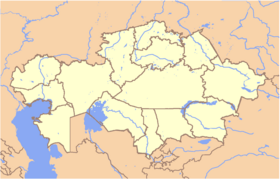Karaganda
| Karaganda Қарағанды |
|||
|
|
|||
|
|||
 Karaganda
|
|||
| Coordinates: | |||
| Country | |
||
|---|---|---|---|
| Province | Karagandy Province | ||
| Founded | 1931 | ||
| Government | |||
| - Akim (mayor) | Islam Togaybayev | ||
| Area | |||
| - Total | 543.28 km² (209.8 sq mi) | ||
| Population (1 January 2006) | |||
| - Total | 446, 200 | ||
| Time zone | BTT (UTC+6) | ||
| Postal code | 100001 - 100030 | ||
| Area code(s) | +7 7212 | ||
| Website: http://www.karaganda.kz | |||
Karaganda, also spelled Karagandy (Kazakh: Қарағанды, Russian: Караганда), is the capital of Karagandy Province in Kazakhstan. It is located at . It is the fourth most populous city in Kazakhstan, behind Almaty, Astana and Shymkent, with a population of 446,200 (as of 1 January 2006).[1] In the 1940s up to 70% of the city's inhabitants were ethnic Germans. Most of the ethnic Germans are descendants of Soviet Volga Germans who were collectively deported to Siberia and Kazakhstan on Stalin's order when Hitler invaded Poland. Until the 1950s many were interned in labor camps often only due to their heritage. The population of Karaganda fell by 14% from 1989-1999, it was once Kazakhstan's second largest city after Alma-Ata. One hundred thousand people have since emigrated to Germany.
The name "Karagandy" is derived from a "caragana" bushes (Caragana arborescens, Caragana frutex) which are abundant in the area. Karaganda is an industrial city, built to exploit nearby coal mines using the slave work of prisoners of labor camps. Commercial extraction of coal continues to be an important activity in the region even today. In the early 1990s, it was briefly considered as a candidate for the capital of the (then) recently independent Republic of Kazakhstan, but its bid was turned down in favor of Astana.
It is the birthplace of the late Chechen President Aslan Maskhadov. It is also the home city of Kazakh World War II hero Nurken Abdirov. A statue in Abdirov's honor is located in the center of the city.
The original site of Karaganda is now labeled on city maps as the "Old Town," but almost nothing remains on that site. In exploiting the rich coal deposits next door, the Soviets undermined the entire city, and the town had to be abandoned completely and moved several miles to the south.
Contents |
EMP
Karaganda suffered the most severe electromagnetic pulse effects ever observed in history, when its electrical power plant was set on fire by currents induced in a 1,000 km long shallow buried power cable by Soviet Test ‘184’ on 22 October 1962. The test was part of ‘Operation K’ (ABM System A proof tests), and consisted of a 300-kt nuclear explosion at 290-km altitude over Zhezkazgan. Prompt gamma ray-produced EMP induced a current of 2,500 amps measured by spark gaps in a 570-km stretch of overhead telephone line to Zharyq, blowing all the protective fuses. The late-time MHD-EMP was of low enough frequency to enable it to penetrate the 90 cm into the ground, overloading a shallow buried lead and steel tape-protected 1,000-km long power cable between Aqmola and Almaty, firing circuit breakers and setting the Karaganda power plant on fire [1].
Karaganda is often used as the punchline in a popular joke in the former Soviet Union. Karaganda is fairly isolated in a vast area of uninhabited steppe, and is thought by many to be "the middle of nowhere". When used in the locative case (Караганде), the final syllable rhymes with the Russian word for "where" (где), as well as with a Russian obscenity used to answer to an unwanted question "Where?". Thus the exchange: "Where is it?" "In Karaganda!"
Further reading
Kate Brown, "Gridded Lives: Why Kazakhstan and Montana are Nearly the Same Place." American Historical Review 106, 1 (2001): 17-48.
See also
- Kaisha Atakhanova (biologist)
- Sary-Arka Airport
References
- ↑ "Акимат Карагандинской области. «Караганда. Паспорт региона.»" (in ru). Retrieved on 2007-07-26.
|
||||||||
